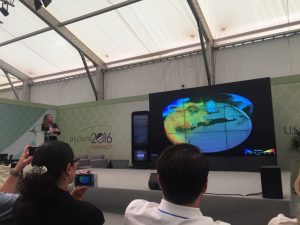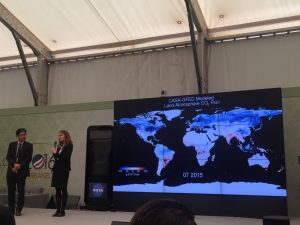Friday was the last day of COP22 and while I will post a blog on my reflection of the entire COP next week I wanted to discuss something of particular interest that profoundly changed my thought process.
If you are a semi-active reader of climate change issues you will have heard that the Amazon rainforest and the Central African rainforests are considered the “Lungs of the Earth.” I heard this phrase before countless times. This week I really learned the deeper meaning of that phrase.
For reference, at the COP many different countries had their own pavilion where each country could showcase the work they were doing to combat climate change. The United States’ pavilion included U.S. Diplomats, members from NOAA, the EPA, Department of Agriculture and NASA. The NASA folks were giving a talk about some of their climate models and were showing them on a big television for a crowd of 50 or so.
One model in particular, captivated me. It showed the amount of Carbon Dioxide (the main greenhouse gas pollutant) in the atmosphere over time, how high in the atmosphere it was and what landmass it covered. CO2 was very prevalent over China’s manufacturing hubs, the United States Midwest and parts of Europe. However, Brazil and Central Africa were particularly interesting.


These two parts of the world have the densest and some of the most famous rainforests ranging from the Amazon to the Congo. Above each geographic location there would be almost as much CO2 as above China but then it would disappear. As the model sped up to show the change over a period of months, the two areas pulsated with CO2, creating the image of a heartbeat or a lung expanding and contracting. I truly understood why these parts of the world were called “the Lungs of the Earth.”
I am not sure why this captivated me so much. Maybe because when you generally think of the earth, you think of this massive and almost indestructible body. How could one species irreversibly damage the entire ocean let alone the entire atmosphere? It is something so difficult to see from the viewpoint of a single person. But to look at the Earth as a single organism, with lungs or a heart that beats just like ours do, we realize how fragile it can be.
I once read a book in high school called “the Hot Zone” about the origins of Ebola. At the very end the author pointed out that the most similar living organism to Ebola, and viruses generally, were humans. To the author we are a parasite on the earth, by giving little back but taking a great amount as we spread throughout the entire planet. While I do not want to believe we are the equivalent of a virus, seeing the Earth through this climate model definitely shows how fragile the earth is and how we can become a virus if we do not watch our actions. The earth is just one deep breath away from collapse.
For more information please see NASA’s website. NASA will be releasing the particular video I spoke of in December 2016. https://www.nasa.gov/press-release/nasa-releases-detailed-global-climate-change-projections